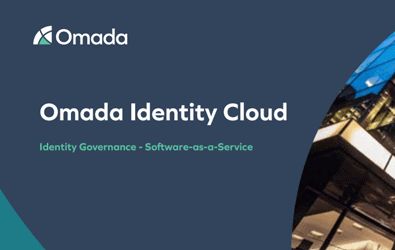Every aspect of business operations that an organization leverages has become dramatically more complex over the last several years as companies have streamlined their teams to be more agile. To meet the security demands of this new environment effectively and efficiently, it is critical that organizations can onboard and update identities and applications safely and expeditiously. In a recent preview webinar of our next release of Omada Identity Cloud, Omada’s Chief Technology Architect Nils Böckmann, and our Vice President of Product Strategy Rod Simmons explain how the next generation of Omada Identity Cloud, delivers the core capabilities organizations must have in a real time identity governance solution. This post provides an overview of the value this new solution update brings to Omada Identity Cloud and why these new capabilities are essential to effective identity governance today and in the future.
Two key identity governance challenges for evolving organizations
Every organization must ask what the principal challenges are when adopting any solution that touches core business applications:
- Can they get data and process it quickly so they can meet governance and compliance requirements in real time?
- Can they get users and applications to contribute securely to the organization right away?
Many organizations currently cannot, and they need more robust functionality to onboard users and applications faster as well as leverage their IGA data to improve processes across the board. Further in this blog post, we look at what this functionality looks like.
The need for onboarding speed
There is no shortage of systems that organizations must add to their identity governance architecture. Most enterprise organizations have over 100 applications in use by business users regularly. Throughout a single project lifecycle, a team may need to onboard and offboard dozens or even hundreds of new entities. Many organizations cannot keep up with the sheer volume. There are many instances where entire departments are not been onboarded to their organization’s governance platform. Without an efficient data pipeline that provides updates for user access needed, there can be significant productivity loss that directly impacts the bottom line. Think about de-provisioning, a core use case for every IGA solution. There is no common compliance standard that calls for de-provisioning a user within a set time. Rather, the mandate is vague; calling for “immediate” or “quick” action. In highly privileged access use cases, the appropriate time for deprovisioning is between zero and two hours. For the termination of standard access, the deprovisioning goal is within five hours. Your core solution must be able to onboard new identities in real time and de-provision just as fast if not faster. Imagine the damage an attacker can have in five hours. For many organizations, this is an aspirational goal at best. With the next generation of Omada Identity Cloud, we make this goal achievable.
The underlying architecture of the solution must also be designed to scale to the speed of business as it gets more complex. This is a principal consideration for growing organizations that, through acquisition, are adding thousands of new identities at one time.
Leverage your IGA solution across the enterprise at scale
To ensure your governance architecture can scale, it must be able to leverage modern technologies like machine learning (ML) and AI. Most compliance and governance professionals say when auditors are sitting at their desks, they need to demonstrate they have the processes in place to satisfy all mandates and requirements. They must show stakeholders their governance solution ensures the safety of their customers and organizational data. To this end, Omada emphasizes the importance of leveraging identity data to improve the larger enterprise ecosystem. Omada is doing this with the addition of AI to the Omada Identity Cloud, by leveraging an open flexible data model, organizations can embed the intelligence across their identity ecosystem and the management of their application access. Omada will ship several updates around AI/ML in 2024.
Faster data ingestion for faster identity management
The challenge for real time identity governance is creating a way to deliver actionable data to use in onboarding, offboarding, and intradepartmental movement. Omada Identity Cloud provides a continuous flow of data that feeds into an event-driven system that then streams the data through different stages to make it available faster. It can merge multiple authoritative sources into one employee record represented in the Omada Identity Cloud.
This new platform also extends the ability of the Omada Identity Cloud to enrich identity information as part of the data loading. For example, let’s say you take employees out of your HR system, but you are managing a subset of contractors or other workforce types in the Omada Identity Cloud. You still want the identities to be available. In addition, you want to be able to easily convert a contractor into an employee. Omada Identity Cloud enables you to do this in minutes.
The next generation of Omada Identity Cloud enables you to import data in two ways: a full import or a delta import. Full import looks at all the data that’s in the system. Delta import determines if a record has changed and only processes records that have changed. This significantly reduces the time until records are available and manageable in the Omada Identity Cloud.
Put ML and AI to work on identity governance
Machine learning and AI are transformative technologies underpinned by massive amounts of data and algorithms that require significant effort to operationalize. The future releases of Omada Identity Cloud will leverage ML and AI to embed functions like role mining directly into the solution. This makes it possible to make the right decision on access rights and role definitions for the company at the speed of business. As your organization evolves, Omada Identity Cloud ensures you have the tooling required to automate identity management that maps to your real-time needs and supports the evolution of your IGA journey.
An ecosystem of APIs
Omada Identity Cloud takes an API-first approach and leverages an ecosystem of APIs to services that talk to each other so that it can provide ongoing support for all identity governance business cases and scenarios. These APIs are both public and private today, but Omada will make more of them available publicly as we have done with the management portal and management APIs for the Omada Identity Cloud. Also, customers will be able to connect their applications by defining an integration using our connectivity framework.
Identity analytics platform
As business becomes more complex, organizations must move beyond simple reporting to an advanced identity analytics platform. Knowing who has access to what and for how long requires being able to prove it. To do this for modern IGA requires customers to be able to customize and schedule reports and manage compliance reporting data right out of the box. The Omada Identity Cloud analytics platform helps to present data to a higher level of your organization where it will enable customers to be able to demonstrate the value Omada delivers for their identity governance investment. Omada will ship several updates around reporting and analytics in 2024.
Learn more about the next generation of Omada Identity Cloud
In this webinar, you’ll see how our next generation of Omada Identity Cloud shakes up the perception of Identity Governance and Administration (IGA) solutions by delivering the first real time Identity Governance platform.
If you have questions or want to learn more about Omada Identity Cloud, book a live demo with one of our IGA experts.




























